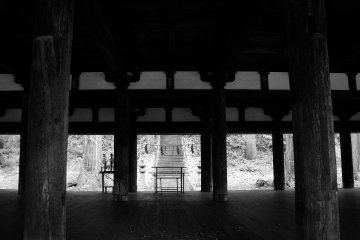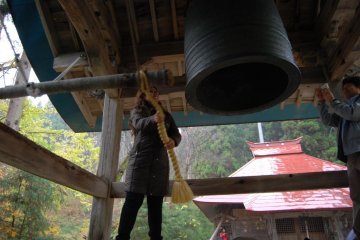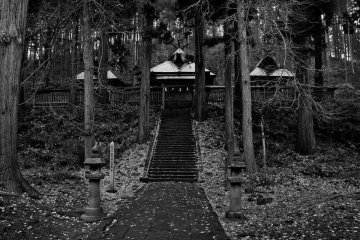The huge 800-year-old gingko tree beside the Shingu Kumano Shrine’s worship hall gives you a sense of the history of the place. When confronted with a date like that, I immediately think about the European dark ages and what Japan might have been like back then. The worship hall (or nagatoko/長床) is even older than the tree, built in 1055. Did they eat the famous Kitakata ramen a thousand years ago in this area?
While the nagatoko is the “national important cultural asset” and chief attraction, according to the English-language literature provided at the front gate, my tactile sensibilities were much more impressed by the huge bell tucked off to the side. I climbed up into the wooden frame housing the bell, and took a much-too-timid whack with the wooden clanger. My reward was slight embarrassment at the resulting weak noise. “Just practicing,” I explained, though nobody was paying attention. Summoning my inner Quasimodo, I tried again with a little bit more oomph. A deep, resounding G-O-N-N-N-G filled the air and reverberated through my body. Whoa. Let’s try that again.
Back on the ground, I spent the rest of my time at Shingu Kumano Shrine wandering around and enjoying the peaceful atmosphere. “Nagatoko” translates as “long floor” and the structure would make an excellent outdoor banquet spot if they would set up some tables and chairs. It’s a wide-open space (27 x 12 meters in area) with a roof and no walls, and it offers some interesting angles and views of the immediate area. My photography-inclined friends busily explored these for artistic possibilities.
The rest of the shrine area is nice, though typical of what you can see at a thousand other shrines in Japan. I liked the dragon’s-head fountain, and did my best to rinse my hands and mouth in the prescribed method. No matter how often people tell me how to do it, I feel like I’m learning again every time I visit another temple or shrine.
And don’t forget (as I almost did) the famous copper pot. Rice was allegedly rinsed in this pot before being offered to the gods, and that’s not something you see every day.










